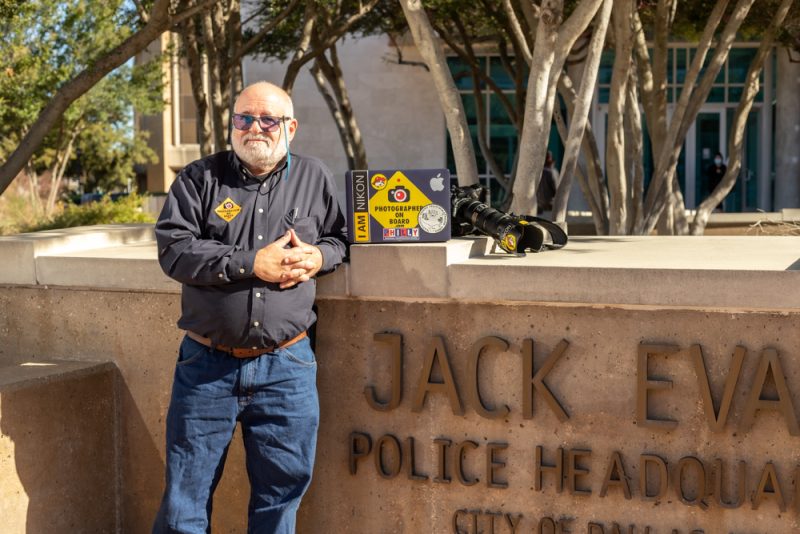
Since the early aughts, East Dallas resident Avi Adelman’s name has appeared in news stories alongside phrases including: “journo terrorist,” “political gadfly,” “most annoying person,” “scourge of Lower Greenville,” “the Grinch that stole Greenville Ave.,” “clashing with police,” “restrained in handcuffs,” “landing in court.”
And there was his self-assigned nickname, Barking Dog, and the eponymous website that he retired a few years ago. At 65, Adelman is still doing his thing — monitoring police activity, zipping around in his Jeep to scenes with dramatic potential, keeping pace with first responders. His website features unexpurgated images — “Nightcrawler” in stills. He also maintains a website called DallasPoliceWatch.com that organizes real-time police reports by subdivision.
The stringer relies on scanners and the City of Dallas Open Data system, which includes Dallas Police Department reports and active call data. And all of those things are at risk of annihilation today, he says.
A fight worth fighting
Since the BD days, Adelman won a $345k settlement from DART after an unlawful arrest while photographing an emergency scene, moved away from his Greenville Avenue battleground to quieter Junius Heights and seems to have started picking his battles a little more selectively.
But he’s riled up about Police Chief Eddie Garcia and the City of Dallas’ plan to remove and delay police information available to the public through Dallas Open Data.
In an Oct. 15 memo to top City of Dallas officials, Dr. Brita Andercheck, the City of Dallas Data Analytics and Business Intelligence director, who is overseeing an overhaul of the police reporting system, said her office had started omitting personal identifying information of complainants. The redo includes further recommendations that have not yet been implemented, including a delay of the Active Calls data set by 24 hours.
Andercheck says the redaction of personally identifiable information (PIL) protects victims of crime.
“Publishing PIL is a privacy and security risk. Including PIL on the Open Data Portal exposes individuals to potential hackers, identity theft and potential reprisals or revictimization,” she says. “Not publishing PIL on the Open Data Portal is bringing the City into alignment with national best practices designed to keep residents safe.”
The delay of active calls, she says, protects the police, public and first responders and “prevents bystanders from interfering at active crime scenes and helps to preserve the integrity of evidence and investigations.”
That “bystanders” part particularly irks Adelman. “I have been to hundreds of crime scenes over the years. I can think of only two or three incidents that had interference, and that usually was a family member going crazy at an accident,” he says. “When crowds are hassling cops, they were attracted by the sirens, the bubble gum lights. Does Garcia propose to stop using sirens and lights too?”
Adelman says the plan would allow police to manipulate information and craft the department’s image, that it would limit police-community transparency and the public’s ability to find out what is happening in their neighborhoods.
“The DPD proposals would kill off the Dallas Police Watch site along with the @DPDCentral Twitter feed,” Adelman says. “What I think is happening is Garcia has got this in his head — he’s a social media relations wizard, for good or bad — and he wants to put a good look on everything.”
Adelman says a 24-hour delay of police calls also will render him far less efficient when it comes to photographing breaking events.
Balancing needs
While Adelman may be the loudest critic of the DPD’s plan, he is not alone in concern.
Paul Landfair runs the website DallasAreaWatch.com where he creates reports for neighborhood crime watch groups across Dallas. (Both he and Adelman have written programs that channel data from the Portal.)
He says if the removal of personally identifying information includes crime scene addresses, it would render his service — used by some 250 single-family neighborhoods and 400 apartment complexes every day, he says — useless.
“Garcia had said there’s some more stuff he wants to redact. That would get me, if he redacted incident addresses,” Landfair says. “My site would be dead. We (those who run similar crime watch sites) would all be dead.”
Landfair’s concern was such that he requested a meeting with Andercheck and Assistant City Manager John Fortune, during which the officials told him they did not plan to remove the incident address. Landfair notes that often the crime, a burglary for instance, occurs at the victim’s address.
Andercheck, whose office assumed responsibility for the Open Data Portal in October 2020 and rebuilt it in 2021, told The Advocate her office is not considering removing incident locations “at this time.”
How would publishing the incident location, when crimes often occur at people’s homes, square with the protecting-the-victim angle?
“There are several considerations on this question,” she says. “The first is, not every crime occurs at someone’s home. The second is, we are balancing a need to protect privacy, with a need to be transparent about where crimes are occurring in our community.”
Dallas City Council members, too, are worried about these changes and department transparency.
At the Public Safety Committee meeting in October, vice chair Cara Mendelsohn insisted that further changes be brought before the full City Council for a broader policy discussion.
“Who else have you consulted? Have we talked to the media, to crime watch groups? Did we get input from residents? I don’t think any of that part happened,” Mendelsohn said to Andercheck.
Mendelsohn, Dallas’ City Council District 12 representative, wondered aloud why it was necessary to remove PIL considering state laws already allow police to redact information related to sexual crimes, juveniles and anything that would hinder an investigation.
“I believe in government transparency for as much information as possible as long as it doesn’t put the city or residents at risk,” she told The Advocate in a follow-up interview. “In this age of policing, establishing and maintaining trust with the public means we need more transparency, not less.”
Garcia said publicly he supports the changes, noting that we are “not the only city who does this.”

Scanners: Soon a thing of the past
When and if the public loses the ability to observe active police calls online, we still have police scanners and Broadcastify and those digital news services such as DFW Scanner or Smash Da Topic for real-time reports and updates, right?
Not for long. Dallas Police Department is working toward a radio system replacement plan — has been for the past four years — that would “enable encrypted communications that cannot be intercepted by a third party.”
With its existing system the DPD can’t encrypt communication, but they can once they have this new system in place, thus the public’s police-scanner listening days are numbered.
The only holdup is that the replacement system costs $6.6 million.
Adelman, who was one of the first on the scene of, for example, a house explosion in Oak Cliff last summer, says in addition to active calls data, he uses scanners. He bought two at Target for $90 each.
According to the tech-media newsletter Built In, 280,000 people tuned into the police scanner service Broadcastify over two days of police protests in 2020.
Built In reporter Stephen Gossett notes that, “as popularity in app-based police radio scanners ballooned in 2020, many departments began to encrypt their radio communications so only those within the department can receive messages.”
He goes on, “This presents an issue with public transparency, eliminating the ability for people to maintain real-time security within their own communities and reducing the already dwindling trust offered toward local police departments.”
Both scanners and active-incident data must be approached with the understanding that they are not in and of themselves news.
They are tools that allow reporters to follow an incident. They offer a starting point as well as a record on which to reflect when something does become an important story.
Will people misuse these tools? Of course.
Many — from hobbyists to journalists and law enforcement officials themselves, even, according to Gossett’s reporting — say that does not mean we should be kept in the dark about potential crime, violence or other police activity in our neighborhood.
The U.S. Department of Justice “Toolkit for policing” sums up the role and responsibilities of police and the community.
“Transparency is essential to positive police-community relationships. When a critical incident occurs, agencies should try to release as much information about it as possible, as soon as possible, so the community will not feel that information is being purposefully withheld from them.
“It is also important to stress that the first information to emerge following a critical incident is preliminary and may change as more information becomes available,” the literature continues. “Police leaders should let the news media and the public know that early information may not be correct, and should correct any misinformation quickly.”
Proposed updates to the City of Dallas Open Data portal will go before the Dallas City Council prior to further changes. At time of publication, the item was not yet on the council’s agenda.





